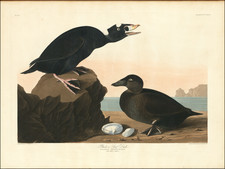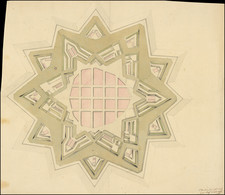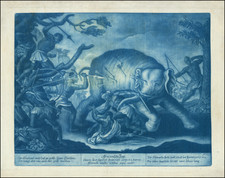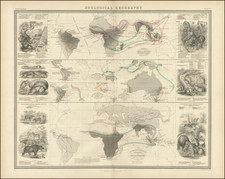The Collared Peccary, depicted by John James Audubon and lithographed and colored by J.T. Bowen in Philadelphia in 1844, is a dramatic testament to the natural history work of the 19th century. The illustration captures the peccary, known by its Latin binomial as Dycoteles torquatus, in a distinct Texan landscape, emphasizing the creature's natural habitat with a prominent prickly pear cactus and an undisturbed terrain that stretches out behind the central figure.
John James Audubon, an ornithologist, naturalist, and painter, is renowned for his efforts to document all the bird species of America, resulting in the seminal work The Birds of America. But Audubon's pursuits were not limited to avian life; this illustration serves as an example of his broader interest in the continent's fauna. The Collared Peccary, a mammal native to the American Southwest, is depicted in its natural setting, reflecting Audubon's commitment to portraying animals in their native environments, enhancing the viewer's understanding of their ecology and behaviors.
The period of the mid-19th century saw a burgeoning interest in the natural world, with explorations and expeditions being undertaken to document previously unknown species and terrains. Texas, annexed to the United States in 1845, represented a frontier of biodiversity, and the inclusion of the Collared Peccary in Audubon's collection indicates the region's rich ecological importance.
The lithographic process, managed by J.T. Bowen, ensured that the details of Audubon's original drawing were retained, from the notable large teeth of the peccary, which it displays prominently, to the nuanced shading of the surrounding Texan landscape. Notably, the peccary is presented against a backdrop of a calm yet detailed landscape, a signature approach of Audubon that underscores the relationship between the animal and its environment.
The inclusion of distinct flora, such as the prickly pear cactus, situates the viewer immediately within the peccary's habitat, emphasizing the region's unique ecosystem. This representation, in conjunction with the naturalistic stance and detailing of the peccary, solidifies Audubon's reputation as a meticulous observer, dedicated to representing the authentic essence of his subjects.
The Viviparous Quadrupeds of North America: Imperial Folio Edition
John James Audubon, best known for his groundbreaking work The Birds of America, embarked on another ambitious project in the later years of his life: documenting the mammals of North America. This endeavor culminated in the creation of Viviparous Quadrupeds of North America, a substantial and influential work that delved into the diverse world of North American mammals with the same depth and artistry that had made his bird illustrations legendary.
John James Audubon (1785-1851), born Jean-Jacques Rabin in Haiti on April 26, 1785, was a Franco-American ornithologist, naturalist, and painter, celebrated for his detailed illustrations of North American birds in their natural habitats. His major work, a color-plate book titled The Birds of America, is considered one of the finest ornithological works ever produced.
Audubon's early years were shaped by tumultuous events. Born out of wedlock in the French Caribbean colony of Saint-Domingue (now Haiti) to a Creole mother and a French sea captain, he was smuggled to Nantes, France, during a slave rebellion. There, he was adopted by his father and stepmother and raised as their own. His childhood in France was filled with outdoor adventures and initial forays into drawing.
In 1803, to avoid conscription into Napoleon's army, he was sent to America, where he managed one of his father's estates near Philadelphia. This move further kindled his profound interest in the wildlife of the New World. Despite a few failed business ventures and challenges, Audubon remained committed to his passion for nature and art.
His dream to document all of the birds of America began to take form in the 1810s. Travelling through America's wilderness, Audubon observed, hunted, and painted birds. He developed a particular technique that involved wiring freshly killed birds into a natural pose on a board. This innovative method combined with his keen observation allowed him to create more lifelike illustrations than many of his contemporaries.
Failing to secure American subscribers or a publisher for his extensive collection, Audubon traveled to the United Kingdom in 1826. There, The Birds of America was met with critical acclaim. Between 1827 and 1838, this work was published in sections, comprising 435 hand-colored, life-sized prints made from engraved plates.
Audubon followed this success with a companion work, Ornithological Biography, which provided detailed narratives about each species. His later work included studies of American mammals, and he became one of the founding members of the New-York Historical Society.
Despite facing numerous challenges throughout his life, including financial hardships and criticism from some peers, Audubon's dedication to his work resulted in an invaluable contribution to ornithology and American art. He died on January 27, 1851, in New York City. Today, his legacy continues, notably through the National Audubon Society, which promotes conservation and appreciation of birds and their habitats.









![[ Janet Taylor -- Pioneer English Astronomer and Naval Navigation Expert ] Chart to Accompany R. Russel's Diagram of Great Circles / R. Russel's Diagram of Great Circles](https://storage.googleapis.com/raremaps/img/small/98801.jpg)
![The Mocock [Original watercolor of a ring-tailed lemur.]](https://storage.googleapis.com/raremaps/img/small/103914.jpg)



